Navigation
Install the app
How to install the app on iOS
Follow along with the video below to see how to install our site as a web app on your home screen.
Note: This feature may not be available in some browsers.
More options
Style variation
You are using an out of date browser. It may not display this or other websites correctly.
You should upgrade or use an alternative browser.
You should upgrade or use an alternative browser.
China Auto Thread
- Thread starter StraightEdge
- Start date
Yommie
SpeedLimited
- Oct 2, 2013
- 64,183
- 37,190
- Country of Origin

- Country of Residence


BYD Yuan UP arrived at dealers ahead of sales start
BYD Yuan UP is a compact electric SUV with an approximate domestic price of 14,000 USD. It offers an HUD, 401 km range, and up to 130 kW.
 carnewschina.com
carnewschina.com
BYD Yuan UP arrived at dealers ahead of sales start
Reading Time: 3 minutes
Denis Bobylev
February 4, 2024
0
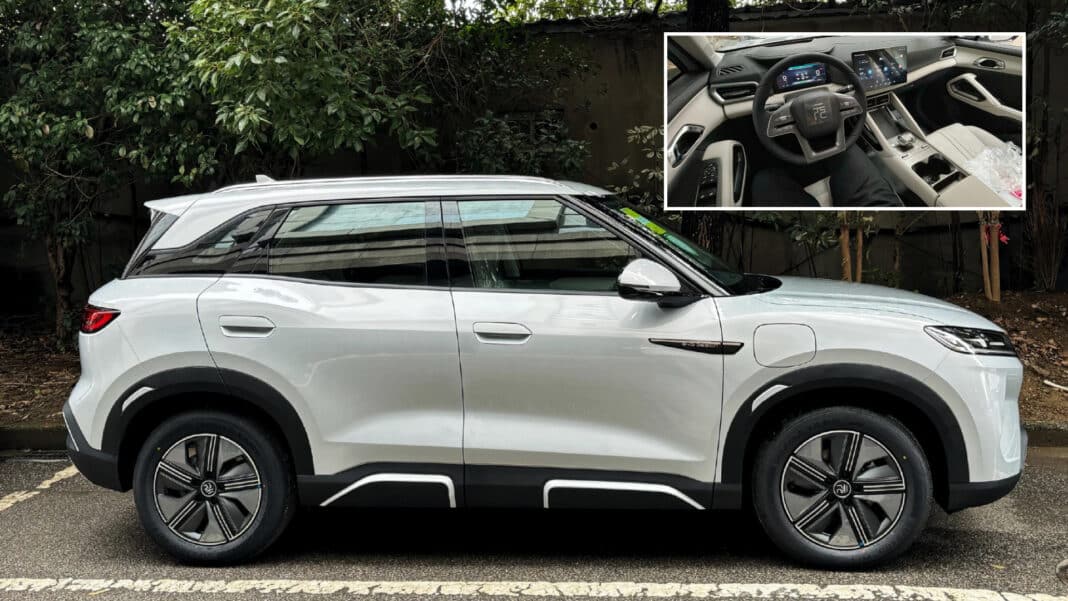
News like this to your inbox or phone?
Weekly summary to your inbox
I want this
Never miss and important news
Get Instant notification once the news is published.
Follow Us
The BYD Yuan UP compact SUV arrived at dealerships in China before the official launch scheduled for March. Its exterior and interior features were revealed. The Yuan UP surprised netizens by offering a heads-up display for 100,000 yuan (14,000 USD).
BYD Yuan UP is the brand’s latest addition to the Dynasty series. This e-Platform 3.0-based compact electric crossover is slightly bigger than the Hyundai Kona EV. It boasts 4310/1830/1675 mm dimensions with a wheelbase of 2620 mm. The Yuan UP has two optional e-motors onboard: 70 kW and 130 kW. Depending on the battery option (32 & 45.1 kWh), this hip SUV can run up to 301-401 km on a single charge. Its price tag will be around 100,000 yuan (14,000 USD).
BYD Yuan UP at dealers

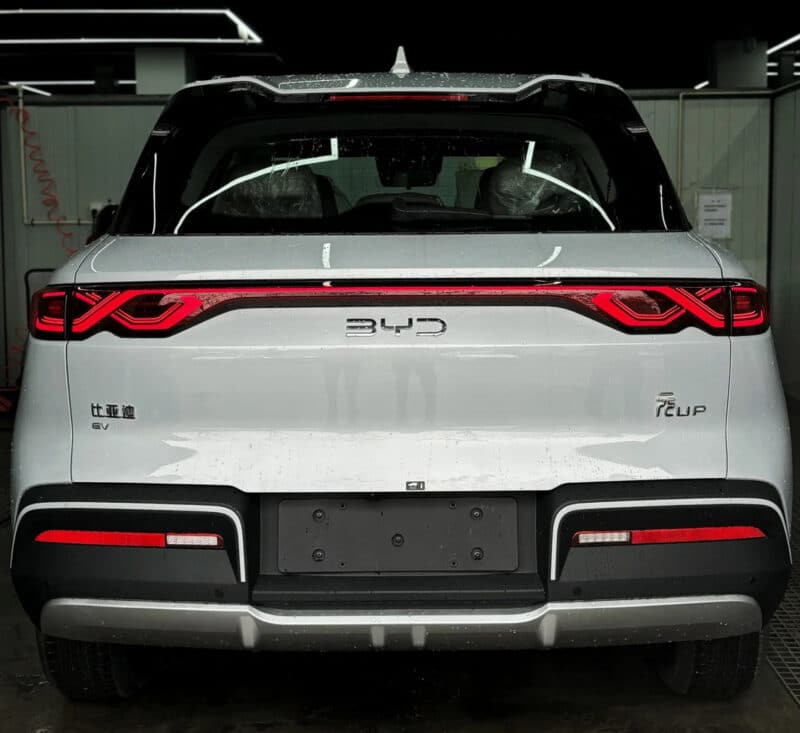
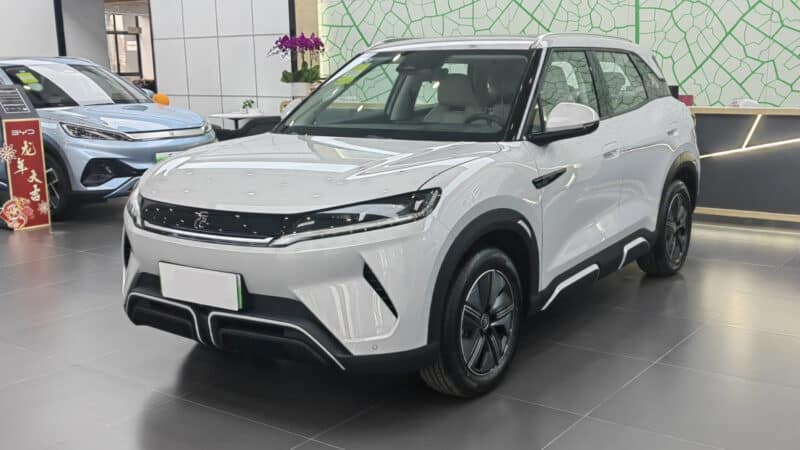
The Yuan UP arrived at several BYD dealerships over the past few days. It will be displayed here to potential customers as BYD is actively preparing the pre-sales launch of this model. The BYD Yuan UP stays in line with previous official render images in terms of exterior design. It has blackened pillars, a suspended roof, flushed door handles, sturdy bumpers, thin LED headlights, and a single taillight unit.
The interior of the BYD Yuan UP was also exposed. Inside, this crossover has a D-shaped steering wheel with four spokes and a signature Yuan (元) logo. An 8.8-inch LCD instrument cluster sits behind the wheel. What is more, the Yuan UP also has a heads-up display. It is quite an achievement for a car of this price tag. The center screen of the Yuan Up can rotate portrait-landscape. Its diameter reaches 12.8 inches.
Yuan UP’s seats are wrapped in perforated leatherette. Both driver and front passenger seats are equipped with power adjustments. The center tunnel of the BYD Yuan Up has a wireless charging pad, a crystal gear selector, and a pair of cup holders. The center tunnel also has a set of physical buttons, including Start/Stop, AutoHold, Hazard Lights, etc.
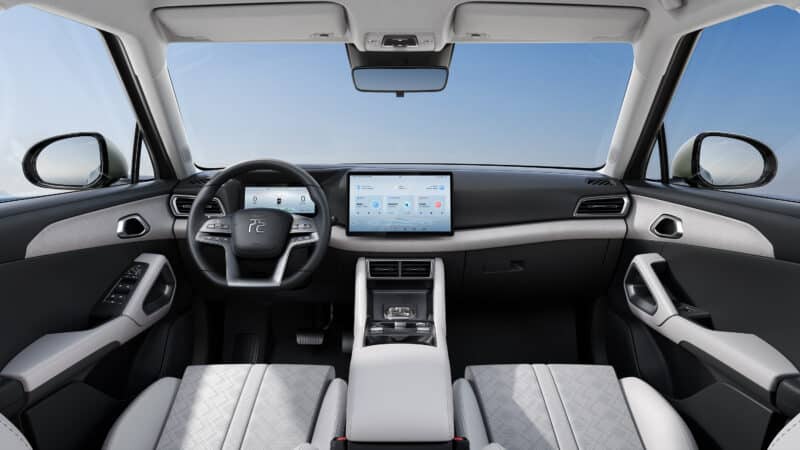
Today, BYD has also shared a set of official interior renders. Its second row has an armrest, and the third has a headrest. At the same time, we can highlight a huge sunroof.
The BYD Yuan UP offers a fairly good trunk capacity for its size. It also equips a parcel shelf, hinges, and a light. The drawback of the trunk is a mass of scratchy plastic. The BYD Yuan UP has a MacPherson suspension in the front axle and a torsion beam in the rear.
As the first batch of Yuan UP crossovers has reached Chinese dealers, BYD is ready to start presales of this model. As for the sales start, it is scheduled for March. More on the BYD Yuan UP as we get it.
Source: Weibo, BYD, Autohome
Yommie
SpeedLimited
- Oct 2, 2013
- 64,183
- 37,190
- Country of Origin

- Country of Residence

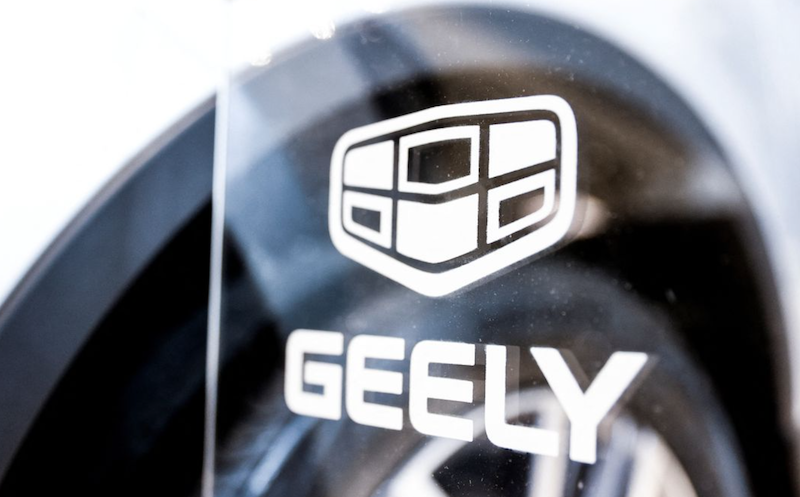
China's Geely Launches 11 Satellites in Autonomous Car Push
The Chinese automaker said it expects to have 72 in orbit by 2025 and eventually a planned ‘constellation’ of 240
 www.asiafinancial.com
www.asiafinancial.com
China’s Geely Launches 11 Satellites in Autonomous Car Push
February 4, 2024The Chinese automaker said it expects to have 72 in orbit by 2025 and eventually a planned ‘constellation’ of 240

Chinese automaker Geely has launched 11 more low-earth orbit satellites, its second large-scale mission, as it accelerates navigation coverage plans for its autonomous vehicles.
The satellites were launched from the Xichang Satellite Launch Center in the southwestern province of Sichuan, Geely Holding Group said in a statement on Saturday.
Geely said it expects 72 to be in orbit by 2025 and eventually plans to have a constellation of 240. The first launch was conducted in June 2022.
In addition to providing high-precision positioning support to self-driving cars, Geely said its network will also serve other commercial functions such as connectivity to the consumer electronics sector.
Also on AF: Japan Warns Trump: ‘Don’t Do a Deal With China If You Win’
The satellites have AI remote sensing functions, providing 1m to 5m clear high-resolution remote sensing imaging, the company said.
China’s satellite networks are dominated by its military but the government began to allow private investment in the country’s space industry in 2014.
Since then, commercial companies, some backed by local governments, have rushed into the sector, with the majority focusing on making satellites and the rest attempting to build small launch vehicles including reusable rockets.
In its latest five-year plan for 2021-2025, Beijing has called for an integrated network of satellites for communications, remote sensing and navigation.
China has more than 400 satellites deployed in space, including commercially owned satellites, according to state media.
- Reuters with additional editing by Sean O’Meara
Last edited:
Yommie
SpeedLimited
- Oct 2, 2013
- 64,183
- 37,190
- Country of Origin

- Country of Residence


Here's how BYD is working on its image problem
As China’s EV giant BYD makes inroads in Europe, it is looking to change its image problem, the old-school way, dealer by dealer.
 electrek.co
electrek.co
Here’s how BYD is working on its image problem
41 Comments
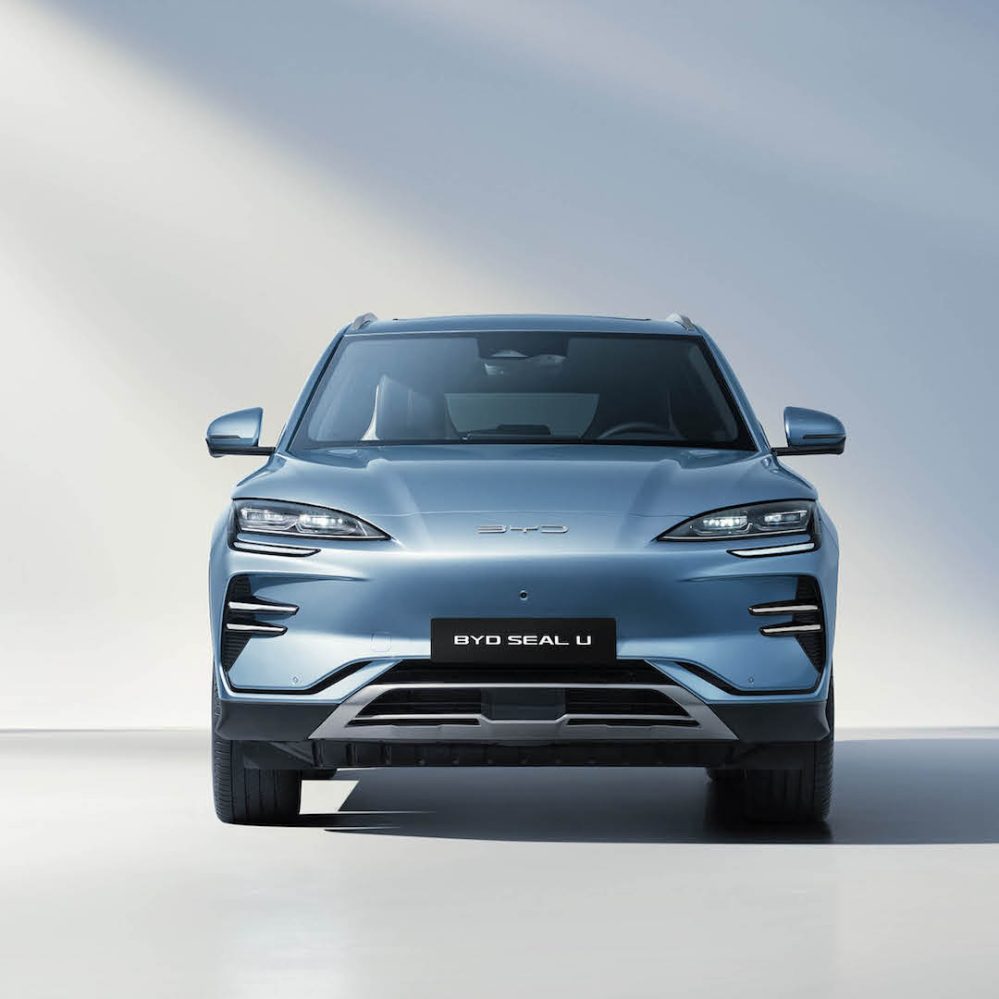
China’s BYD is selling millions of EVs, famously outselling Tesla in the last quarter of 2023, and riding an enormous wave of success. But not many Europeans (and practically no Americans) have ever heard of it, much less trust it as a reliable brand. But as the EV giant makes inroads outside of China, it is looking to change that, the old-school way, dealer by dealer.
While European automakers have been shifting over to direct sales à la Tesla, China’s BYD, for Build Your Dreams, along with Chinese peers Xpend and Great Wall Motor are looking to dealers to build sales and provide networks to help their brands build solid reputations and trust among Europeans. And now, BYD is setting up its BYD-only shop in Germany.
“European consumers have no inkling of Chinese brands,” Daniel Kirchert, the head of e-mobility consultancy Noyo and former BMW executive, told Automotive News Europe. “It’s a huge challenge for Chinese carmakers to make clear to Europeans that their cars are on par with Tesla, at a better price.”
Reuters reports that BYD just opened up its new BYD-only shop in Berlin in its latest move to grow the brand in a country that loves German cars and Teslas. The strategy is to help get German EV shoppers closer to the brand, raise brand awareness, and build sales of its affordable EVs in Europe’s largest automobile market. While BYD has done well in some European markets, it ranks a distant third among China’s Geely’s Volvo, Polestar, and Lotus, and MG brand, owned by SAIC, Automotive New Europe reports.
‘Just like Tesla, only cheaper’
The automaker is putting five models on sale in Germany at a shop owned by dealership Sternauto, which has exclusive rights to sell BYD cars in eastern Germany, Reuters reports. While the Atto3, Han, and Tang surely aren’t stunners, BYD is leaning on the fact that they are practical and affordable – and that strategy has worked well for other automakers expanding globally, such as Korea’s Hyundai and Kia. Plus BYD has thousands of engineers working to ramp up its smart tech game, so BYD is aiming for a just-like-Tesla-only-cheaper angle.
“One of the biggest topics for BYD is that it is not that familiar to German customers,” Oliver Hein, head of BYD for Sternauto, told Reuters. But that is changing, he says, as the brand is investing heavily in marketing.
BYD, too, is sticking to the auto show model to build its reputation, and will be among just a handful of big-name automakers attending the Geneva Motor Show, including Renault, Dacia, BG, and Lucid.
Last year, the company sold 1.6 million fully battery-electric vehicles, overtaking Telsa in overall BEV sales. Adding up sales for all so-called new energy vehicles, including battery-only vehicles and plug-in hybrids, BYD sold 3 million vehicles in 2023. Still, 90% of its revenue comes from sales in China.
While BYD is targeting Germany, which has been among the global leaders in its transition to EVs, the country is expected to see a 14% drop in EV sales this year.
BYD is also among the Chinese companies that have come under harsh scrutiny from Europe due to subsidy policies that put Europe at a competitive disadvantage, all while being thrust into a trade war with North America and Europe.
Meanwhile, the US and Europe are tightening their rules on Chinese cars and EV parts being sold in their countries, with tariffs so high in the US that China has turned its focus on other areas, namely South America, Asia, and Europe.
Electrek reported yesterday that BYD had just signed a preliminary land purchase deal for its EV plant in Hungary. It is also building plants in Brazil and Thailand.
Yommie
SpeedLimited
- Oct 2, 2013
- 64,183
- 37,190
- Country of Origin

- Country of Residence


XNGP Intelligent Driving: Xpeng releases a comprehensive FAQ
Xpeng releases FAQ about its autonomous driving tech.
 carnewschina.com
carnewschina.com
XNGP Intelligent Driving: Xpeng releases a comprehensive FAQ
Reading Time: 3 minutes
Naveed Rastegar
February 5, 2024
0
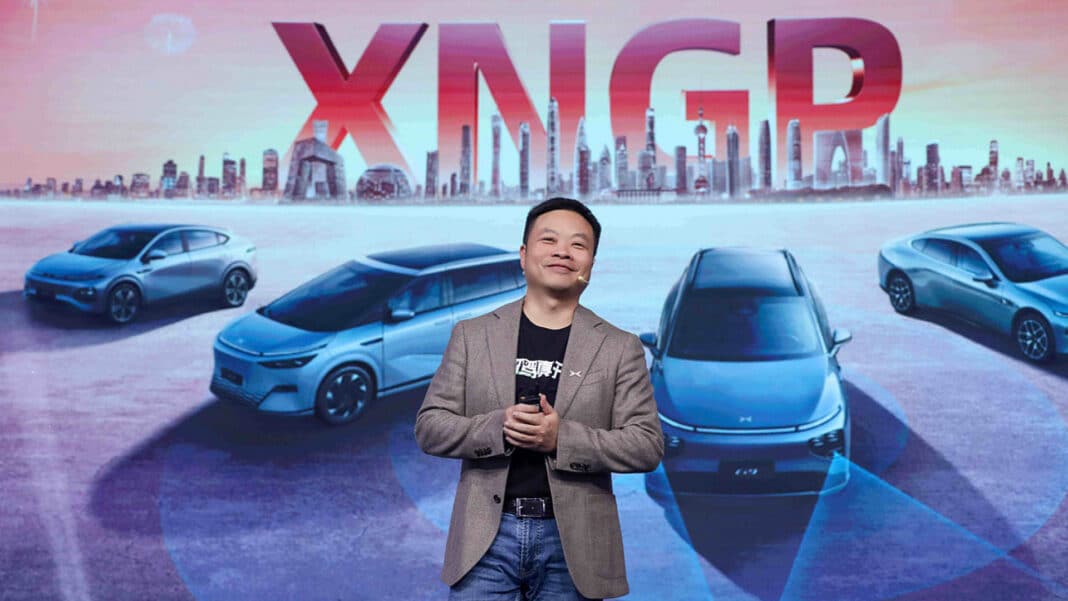
News like this to your inbox or phone?
Weekly summary to your inbox
I want this
Never miss and important news
Get Instant notification once the news is published.
Follow Us
Xpeng, the Chinese EV maker, recently released a comprehensive FAQ about its XNGP intelligent driving technology. It addresses various questions and concerns that users and potential buyers of Xpeng vehicles may have regarding the company’s advanced autonomous driving capabilities.
Xpeng has been at the forefront of autonomous driving in China, and its main competitors are Tesla’s FSD and BYD’s DNP. Other technology companies, such as Baidu (with Geely partnerships) and Huawei (Aito and Avatr), are also in the race to bring intelligent driving to the domestic market in China.
One question frequently asked by potential buyers is whether they should choose the Pro version or the Max version when purchasing models such as the G6, P7i, G9, or X9. The main difference between the two versions lies in the type of intelligent driving. The Max version, equipped with two lidar sensors and a chip with 508 TOPS computing power, supports both highway and city navigation-assisted driving. On the other hand, the Pro version only supports highway navigation-assisted driving and can only utilize ACC (Adaptive Cruise Control) and LCC (Lane Centering Control) in city roads.

To determine if XNGP supports their city or will be supported in the future, users can refer to the list of cities provided by Xpeng. Currently, XNGP is available in 243 cities, making Xpeng the automaker with the largest number of cities where its intelligent driving technology is accessible. Furthermore, Xpeng plans to expand its coverage to include major cities like Chongqing, Jinan, Hefei, Zhengzhou, and Kunming throughout 2024. The global version of XNGP is currently under development and is set to be released sometime in 2025. Without a global version, Xpeng can not hope to compete with Tesla in the autonomous driving sector in Europe, where Xpeng vehicles are currently sold.
While XNGP already covers many cities in southern China, some users have wondered when the technology will be available in northeastern cities. Xpeng explains that due to the heavy snowfall and slippery road conditions in northern regions during the winter, the opening of XNGP in these cities has been temporarily delayed to ensure user safety. However, Xpeng reassures users that their goal is to cover all cities in China eventually and that they are working hard to speed up the process.
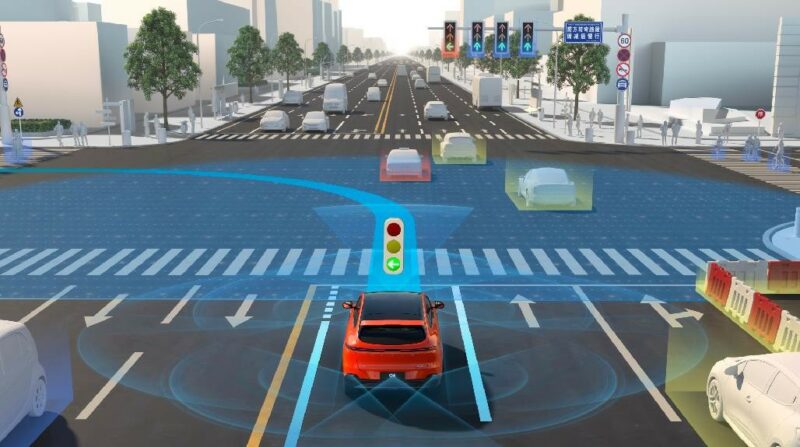
The FAQ also provides guidance on how to activate and use the intelligent driving features of XNGP. Users can activate the assisted driving features by selecting the appropriate mode in the vehicle’s control panel. Once activated, the vehicle will automatically maintain a safe distance from the vehicle in front and stay within the lane. Users are advised to keep their hands on the steering wheel and be prepared to take control of the vehicle if necessary.
The FAQ also addresses concerns about the safety of XNGP. Xpeng emphasizes that safety is their top priority and that XNGP is designed to enhance driving safety and convenience. The system undergoes rigorous testing and validation to ensure its reliability. Xpeng also collaborates with regulatory authorities and industry organizations to establish standards and guidelines for autonomous driving. Late last year, Xpeng released a video demonstration of some of its capabilities in China.
In terms of software updates, Xpeng provides over-the-air (OTA) updates to improve the performance and capabilities of XNGP continuously. Xpeng’s FAQ provides information about the capabilities, coverage, and usage of XNGP intelligent driving technology. It aims to address user concerns and provide transparency about the features and limitations of the system.
Source: Xpeng
Yommie
SpeedLimited
- Oct 2, 2013
- 64,183
- 37,190
- Country of Origin

- Country of Residence


BYD’s YangWang U7 revealed 800-km range with 135.5 kWh battery
The YangWang U7 is a luxury sedan from BYD. It will start sales in China this year with a price tag of 140K USD.
 carnewschina.com
carnewschina.com
BYD’s YangWang U7 revealed 800-km range with 135.5 kWh battery
Reading Time: 2 minutes
Denis Bobylev
February 5, 2024
0

BYD’s upcoming high-end sedan YangWang U7 will have two CLTC cruising ranges: 720 km and 800 km. This information was revealed in the latest catalog of NEVs exempted from vehicle purchase tax released by the Chinese Ministry of Industry and Information Technology (MIIT). The U7 applied for the sales license in January and is preparing for the market launch.
YangWang is a luxury brand launched by BYD, the world’s biggest new energy vehicle maker, in 2023. It currently sells a single model, which is the U8 EREV off-roader, with a starting price of over 1 million yuan (140K USD). Now, YangWang works on three more electric models: the U9 sports car, the U7 sedan, and an unnamed fastback crossover.
YangWang U7 range and battery specs
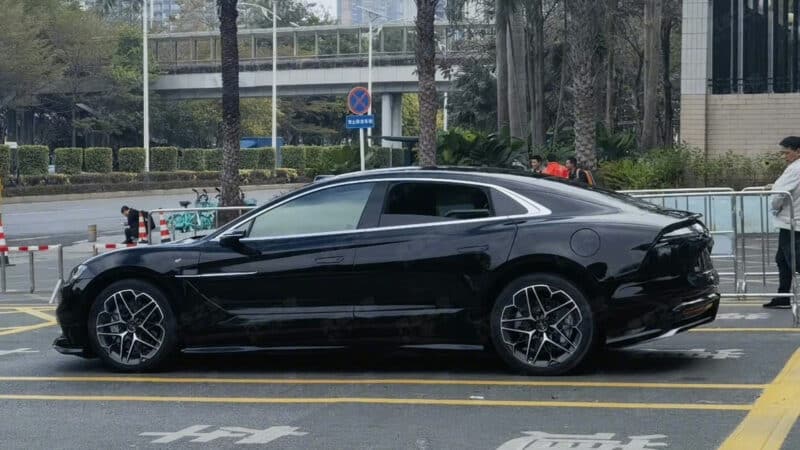
According to MIIT, this beast of a sedan has the LFP battery manufactured by FinDreams, a BYD subsidiary. The YangWang U7’s pack has a capacity of 135.5 kWh. Because of the chemistry formula, the U7’s battery is quite heavy. It weighs 903 kg, accounting for one-third of this saloon’s curb weight of 3095 kilos. For comparison, the Nio 150-kWh battery weighs 575 kg, according to the regulator.
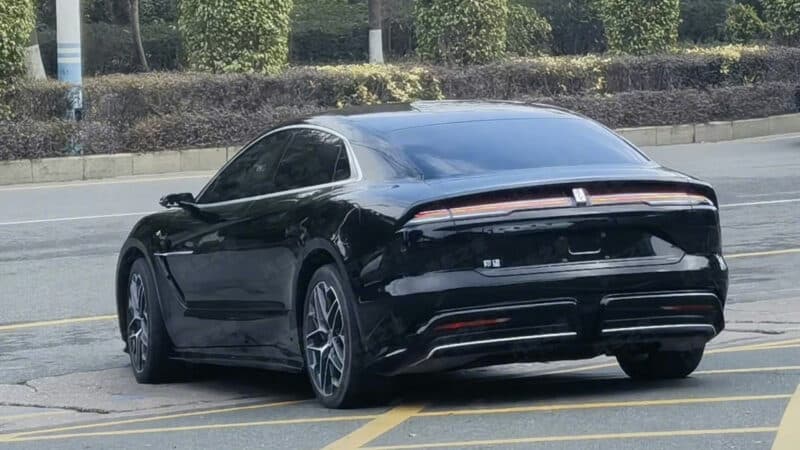
The YangWang U7 has two CLTC range options: for 720 km and 800 km. Since these modifications’ curb weight and the combined power output are similar, the difference is caused by the drag coefficient. The YangWang U7 will offer optional side-view cameras instead of conventional mirrors, aerodynamic wheel covers, and optional bumpers. With all aerodynamic elements installed, the U7’s drag coefficient reaches 0.195 Cd, similar to the Xiaomi SU7.
YangWang U7 specs
The YangWang U7 stands on the e⁴ platform (also known as YiSiFang). Its dimensions are 5265/1998/1517 mm with a wheelbase of 3160 mm. For clarity, it is 42 mm longer, 70 mm wider, and 1 mm lower than the EQS. But the U7’s wheelbase is 50 mm shorter. Inside, the U7 adopts the brand’s signature three-screen layout. The interior has two variants with 4 and 5 seats.The YangWang U7 has four electric motors. Each has a peak power of 240 kW (rated power is 65 kW). The total power output of this saloon reaches 960 kW (1,287 hp). Its top speed is 270 km/h. The YangWang U7 will enter the Chinese market this year, aiming to compete with Mercedes-EQ EQS, BMW i7, Nio ET9 and other high-end electric sedans.
Source: MIIT, Weibo
Yommie
SpeedLimited
- Oct 2, 2013
- 64,183
- 37,190
- Country of Origin

- Country of Residence

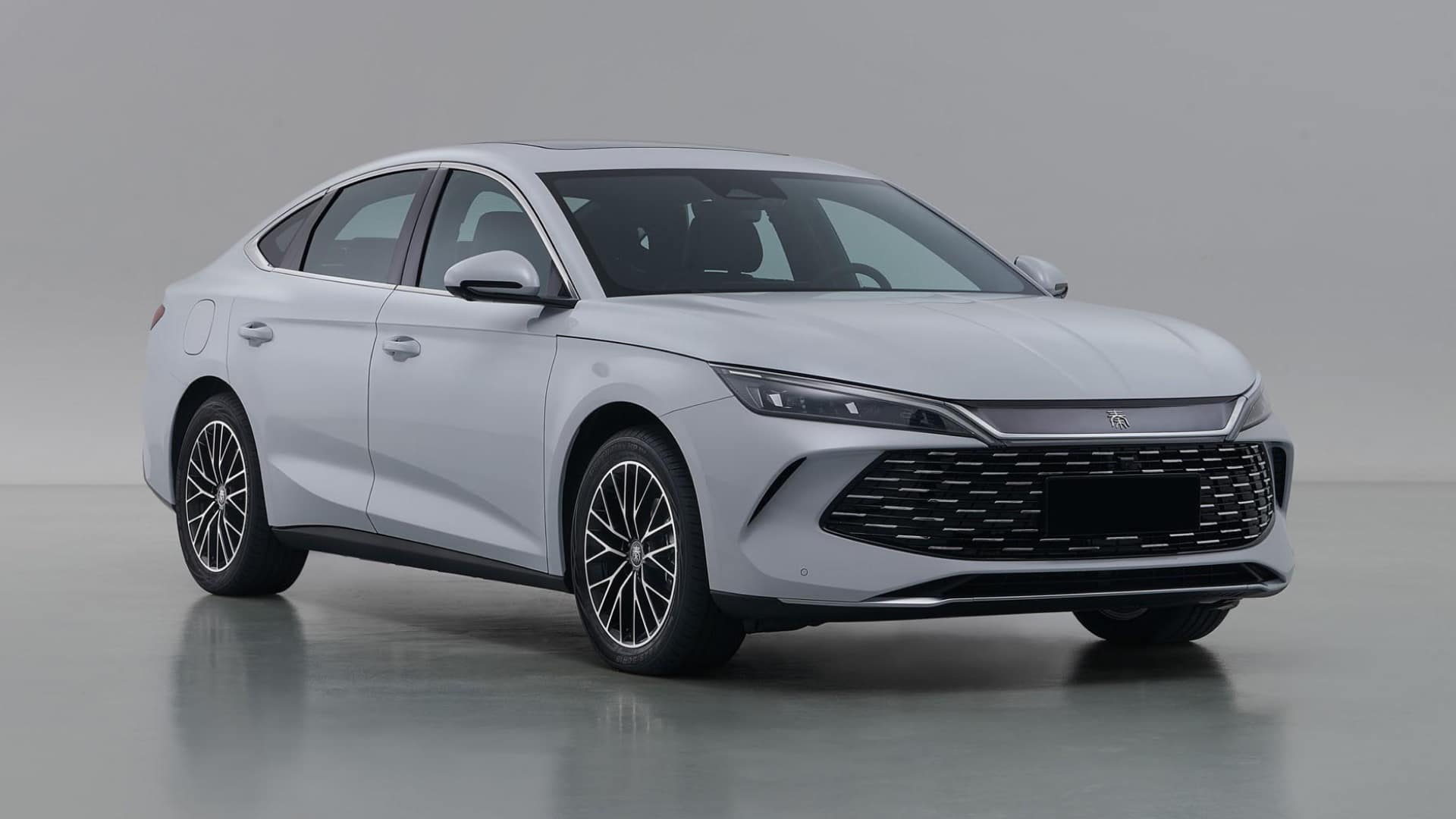
BYD Qin L exposed in China as it applied for sales license
BYD Qin L is a 4.8-meter PHEV sedan with 90 km of electric range and a 5-gen DM-i powertrain. It will enter the market shortly.
 carnewschina.com
carnewschina.com
BYD Qin L exposed in China as it applied for sales license
Reading Time: 3 minutes
Denis Bobylev
February 5, 2024
0

News like this to your inbox or phone?
Weekly summary to your inbox
I want this
Never miss and important news
Get Instant notification once the news is published.
Follow Us
The BYD Qin L is a new mid-size PHEV sedan from the world’s biggest new energy vehicle manufacturer. The Chinese regulator exposed its specs as it applied for the sales license. It is a 4.8-meter saloon with a 5-gen DM-i plug-in hybrid system and up to 90 km of range.
Currently, the BYD’s Qin series comprises a Qin Plus sedan with BEV and PHEV variants. The Qin Plus became one of the brand’s bestselling cars last year, with deliveries of over 482,000 units in 12 months. Now, BYD has prepared an addition to the Qin family, the Qin L sedan.
BYD Qin L exterior and specs
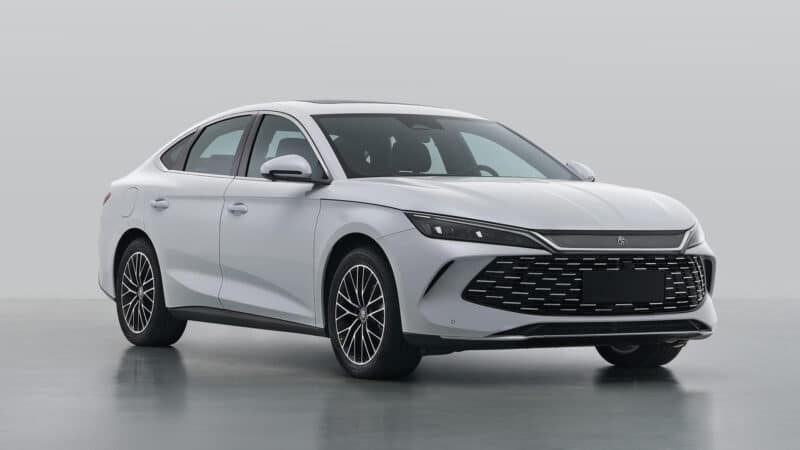
Previously, the BYD Qin L was spotted in China. However, the regulatory filings allowed us to glance at this sedan in detail. The Qin L adopts the brand’s latest Dragon Face design from the ex-Audi veteran Wolfgang Egger. It has a large hexagon-shaped grille that refers to the dragon’s open mouth. It is available with optional chrome plating. The front bumper of the Qin L has two air vents and a thin trapeze-shaped air intake.

Its other distinguishing features are thin headlights, conventional door handles, side-view mirrors, and a distinguishing Qin (秦) badge in the front end. From the back, the Qin L has a single taillight unit with the Chinese knot pattern. Its rear bumper has a diffuser to add some sportiness.
Translated by Google
The BYD Qin L dimensions measure at 4830/1900/1495 vv with a wheelbase of 2790 mm. Its front and rear tracks are equal to 1620 mm. Approach and departure angles are 13 and 14 degrees, respectively. And the front and rear overhangs are 970 and 1070 mm. The BYD Qin L rides on three wheel options: 225/60 R16, 225/55 R17, and 225/50 R18. Its curb weight reaches 1660 – 1800 kg, depending on the powertrain option.
BYD Qin L powertrain
Translated by GoogleThe BYD Qin L has a 1.5-liter self-aspirated ICE (BYD472QC) for 74 kW. It is paired with the TZ210XYB electric motor for 120 kW (rated power is 55 kW). There is also a more powerful version of this sedan with a TZ210XYC e-motor for 160 kW (rated power: 70 kW). However, the top speed of both variants is limited to 180 km/h.
Previously, BYD Qin L’s battery and range options were exposed. Based on the earlier leaked information, we can conclude this sedan has two powertrain variants.
- Qin L DM-i 60 km
- 1.5-liter self-aspirated ICE for 74 kW + electric motor for 120 kW
- 10.08-kWh LFP battery, 60 km of electric range, 3.8 L/100 km fuel consumption
- Qin L DM-i 90 km
- 1.5-liter self-aspirated ICE for 74 kW + electric motor for 160 kW
- 15.87-kWh LFP battery, 90 km of electric range, 3.98 L/100 km fuel consumption
Source: MIIT
Yommie
SpeedLimited
- Oct 2, 2013
- 64,183
- 37,190
- Country of Origin

- Country of Residence


BYD Seal 06 sedan revealed in China
The Seal was supposed to be a sole model, but BYD quitely turned it into a whole new series.
 carnewschina.com
carnewschina.com
BYD Seal 06 sedan revealed in China
Reading Time: 3 minutes
Jiri Opletal
February 5, 2024
0

News like this to your inbox or phone?
Weekly summary to your inbox
I want this
Never miss and important news
Get Instant notification once the news is published.
Follow Us
BYD Seal 06 was revealed by a government regulator in China. It is a plug-in hybrid sedan under the new Seal family, which belongs to the Ocean series.
BYD Seal was initially a sole product. However, BYD quietly turned into a whole product family, which now consists of Seal EV, Seal DM-i PHEV, Seal U (export name for Song Plus), and its newest member, Seal 06.

BYD applied for market homologation for Seal 06, and the Ministry of Industry and Information Technology (MIIT) revealed the application today, including the pictures and critical specifications.
Seal 06 is a 5-seater with dimensions (length/width/height) of 4830/1875/1495 mm, respectively, and the wheelbase is 2790 mm. Based on the drivetrain option, the curb weight is 1660 kg or 1775 kg. The car will come with an optional sunroof.
 Double L shape headlights on Sea Lion 06
Double L shape headlights on Sea Lion 06In front, the PHEV adopts a very new Ocean series design. Unlike other Seal models, it doesn’t have signature “boomerang headlights” but features a new design, which we will call “double L” shape headlights. In the rear, the shape is similar to the BYD Seal DM-i, which has nearly the same width and height. The length has increased by 130 mm, and the wheelbase is now 110 mm longer.
Seal 06 is based on the DM-i hybrid platform and will come in two drive train variants with 120 kWh (TZ210XYB) and 160 kWh (TZ210XYC) electric motors manufactured in BYD’s Hefei factory. Both variants will feature in-house developed BYD472QC 1.5 liter ICE with 74 kW peak power. The maximum speed of both variants is capped at 180 km/h.
The battery will be a Blade battery with Lithium iron phosphate (LFP) chemistry from BYD’s subsidiary FinDreams. MIIT didn’t reveal the battery capacity, but according to CarNewsChina information, it will have two options with a capacity of about 10 kWh and 16 kWh battery packs good for 60 and 90-km CLTC ranges, respectively.
In November, BYD announced another new series called Sea Lion, which focused exclusively on SUVs and will launch three new cars in 2024, including the Sea Lion 06 SUV.
READ ALSO
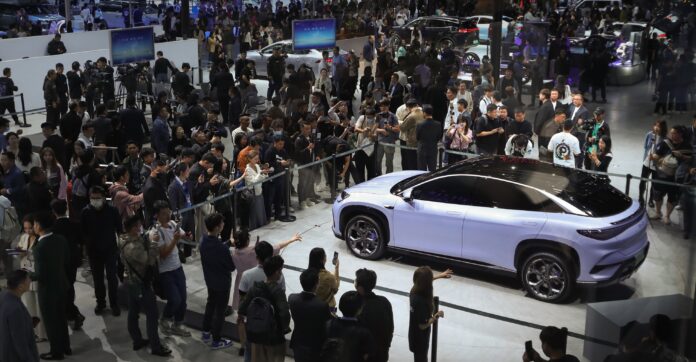
BYD announced Sea Lion is becoming a new product line, with Sea Lion 05 and 06 coming in 2024
Seal 06 will be positioned under BYD Seal and Seal DM-i, more or less on the same level as the recently revealed BYD Qin L. The all-electric version will most likely be introduced later this year. With so many new models incoming, 2024 will be difficult for BYD to avoid cannibalizing sales among its lineup, as the Shenzhen-based automaker has over 100 models and trims on sale in China. We keep keep an eye on it.
Users who are viewing this thread
Total: 1 (members: 0, guests: 1)
Pakistan Defence Latest
-
Iran has requested the Pakistan Air Force to provide training for its fighter pilots! (14 Viewers)
- Latest: mulj
-
-
-
Country Watch Latest
-
-
-
-
-
Egyptian EJun 30 SW, Akinci and the relationship with the United Arab Emirates (3 Viewers)
- Latest: Sami_1
Latest Posts
-
-
-
These big shipyards are China's shipbuilding power players and are cranking out new warships at a breakneck pace (5 Viewers)
- Latest: Beijingwalker
-
-
Breaking News: Saudi Arabia won't recognize Israel without Palestinian State says Crown Prince (4 Viewers)
- Latest: FuturePAF
